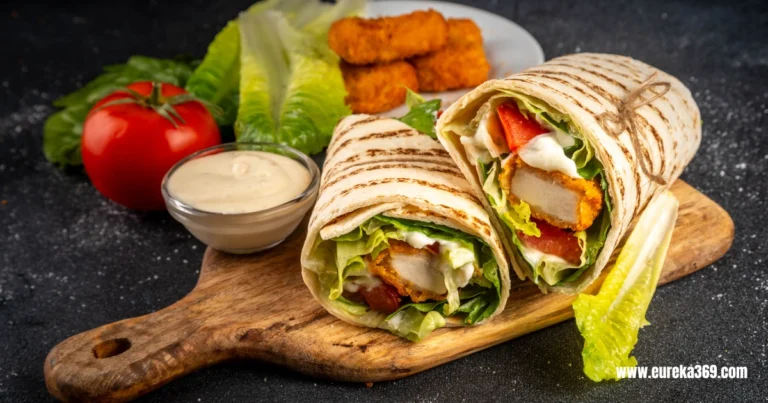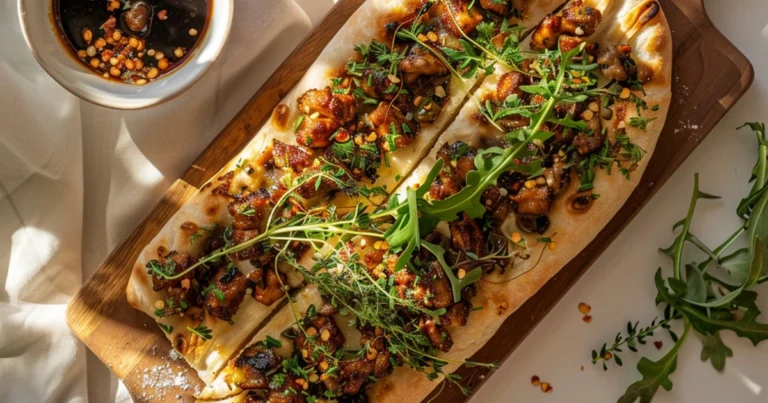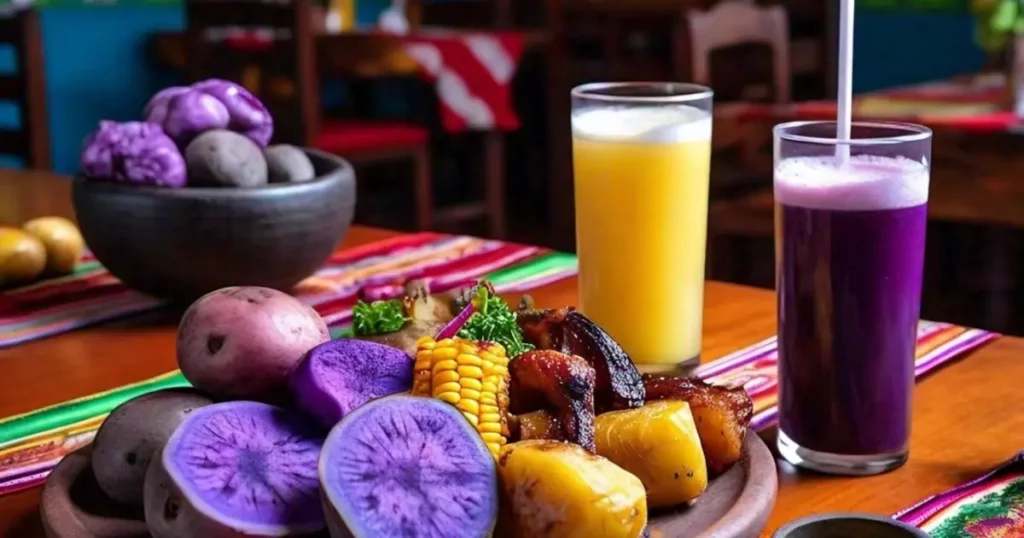
Peruvian cuisine is like a big, beautiful, flavor-packed piñata that you can’t wait to break open and dig into. As diverse as the landscapes across this nation, the cuisine merges indigenous traditions with Spanish colonial influences and ingredients from the coast, mountains, and rainforest. But if you ask me, no single item captures the vibrant spirit of Peruvian cooking quite like the humble and amazingly diverse purple potatoes.
My six-year-old daughter has asked me lately, while having a scrumptious bite of fries, if potatoes can be purple too. Well, purple is her favorite color. She wants everything to be purple in her fantasy world. Though she can at least have purple fries in reality.
You read that right. Over 3,800 different cultivated varieties of potatoes call Peru their ancestral home. That’s freaking mind-blowing, right? Who knew those earthy, knobby tubers could contain such a brilliant rainbow when you peek under their skin?
History of the Purple Legacy
The Andes Mountains region is the undisputed epicenter of the tattooed potato universe and among these fanciful spuds, some varieties are just downright exotic.
Today, around 100 different varieties of purple potatoes are grown in different parts of the world. However, in some regions of the United States, purple potatoes are also known as blue potatoes.
Its famous varieties include Purple Majesty, Purple Peruvian, Purple Fiesta, All Blue, Blue Swede, Blue Elise, Adirondack Blue, Blue Anneliese, St. Galler, Violette, Purple Pelisse, Purple Viking, Congo, and Magic Molly. Furthermore, for commercial production in the United States and Europe, the most widely used variety is All Blue.
Purple Potatoes: One Funky, Flavorful ‘Tater
Stay hooked on exploring one of Peru’s most striking and delectable potato personalities. Let’s dig in to the downright regal “Pituque,” pronounced as “peh-too-keh.”.
Ranging from deep indigo and violet hues to streaks of fiery red, the knobby, finger-shaped Pituque potato looks more like a freshly inked tattoo design than something you would want to eat. But trust me, with a creamy texture and earthy, slightly sweet flavor, this vibrantly colored spud is as delicious as it is aesthetically pleasing.
These stunners get their bold blue blazes from the same anthocyanin antioxidant compound that gives berries like blueberries their punchy pigment. Indigenous Peruvian communities have cultivated the Pituque variety for centuries in the remote, windswept Andes highlands.
In fact, the name Pituque derives from the Quechua word “pit’oq,” meaning “thin” or “wrinkled.” An ode to this spud’s delightfully gnarled, dimpled appearance. Those idiosyncratic tubers thrive in the intense UV rays, wild temperature swings, and mineral-rich volcanic soils of the high-altitude Andean altiplano plateau. All that environmental intensity gifts Pituques with delicious flavor and a satisfyingly firm, starchy texture that’s just begging to be roasted, smashed or stewed.
Purple Potatoes as Colorful Nutritional Powerhouse:
However, Purple potatoes possess a serious nutritional punch. Like many vibrantly-hued fruits and veggies, the deeper blue-purple pigment indicates higher levels of anthocyanin antioxidants.
Anthocyanins are like the grunt workers of the antioxidant family. Studies suggest that they may help reduce inflammation, fight cell-damaging free radicals, protect brain health, and even improve cardiovascular function. Not too shabby for an oddly-shaped potato, right?
But the Pituque’s superfood powers don’t stop there. These unique tubers contain a high quantity of carbs for long-lasting energy, metabolism-revving protein, heart-healthy potassium and fiber, vitamin C to boost immunity, and a range of B vitamins.
From Rugged Seeds to Your Table
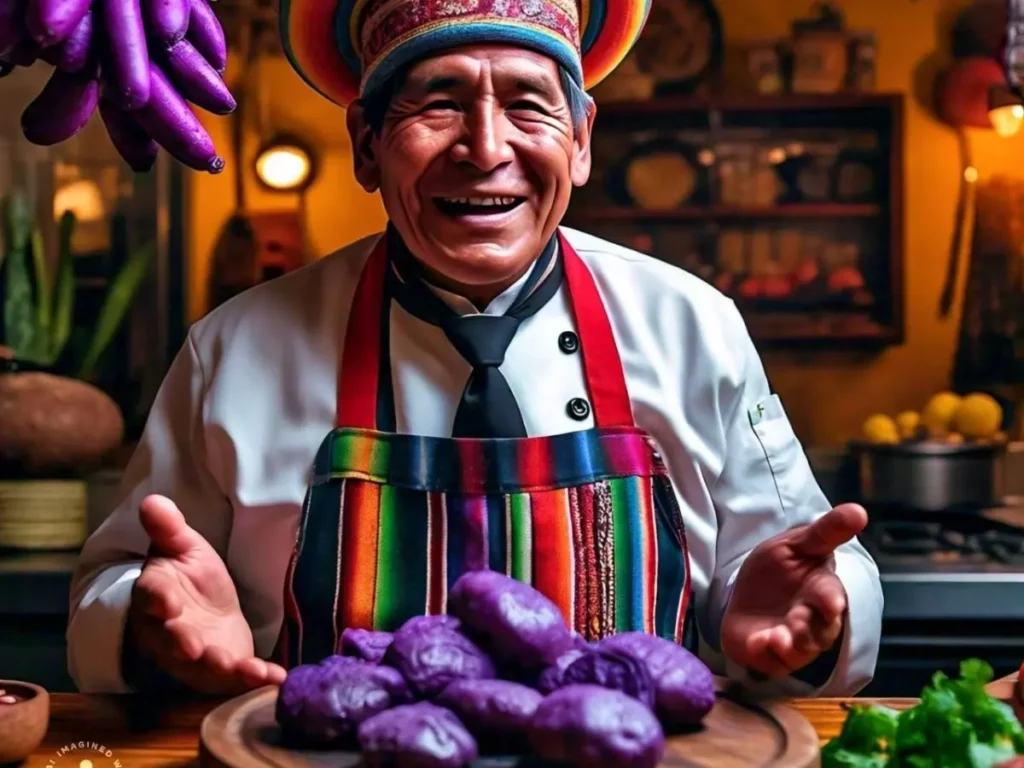
The journey of the purple potatoes from seed to supper pallete is almost as dramatic and harsh as its otherworldly coloring. Rather than using conventional planting methods, many Peruvians cultivate petuque potatoes through seeds to help maintain their diversity.
Come late winter in the Andes, Quechua and Arhuaco farmers carefully sow those fresh potato seeds across terraced fields and sloped mountainsides between 12,000 and 14,000 feet above sea level. As tender sprouts emerge from the fertile soil in early spring, growers engage in the meticulous process of “mapanko,” slowly burying the lower stems to stimulate more tuber growth down below over several months.
By mid-spring, a lush landscape of ankle-high, leafy potato plants blankets the rocky terrain, their luminous color palette ranging from whites to reds, purples, and blues. Those blazing Andean rays fuel photosynthesis while icy winds sweep down from snow-capped peaks overnight.
Eventually, this constant clash of temperature extremes and intense UV exposure actually helps deepen the vibrant pigments within the developing Pituque skins and flesh. Four months later, these uniquely patterned and hued tubers are ready for their laborious hand harvesting process sometime between April and June.
From Roasted Wedges to Age-Old Chuño: Preparing a Purple Potatoes Treasure
Once you manage to procure some of these prized and increasingly popular purple potatoes, the burning question is: how do you cook them? And how do Peruvians use petuque in their cuisine? The great news is that this potato’s particular texture and bold, earthy taste shine through, no matter the preparation.
Peruvians suggest that you toss it in olive oil with a sprinkle of salt and roast until crunchy on the outside and pillowy inside. Which locals serve as a side dish or salad topper? Their brilliant indigo hue provides a colorful canvas for dipping in zesty sauces like a spicy aji amarillo crema or creamy avocado dressing.
Moreover, for a hearty cold-weather stew that will stick to your ribs, boiled and smashed pituques can form the base of classic Andean chuño. A thick, richly flavored potato and meat stew that has fueled highland communities for generations.
Preservation of Pituque: Indigenous Techniques
Speaking of chuño, before we had modern refrigeration and food preservation techniques, indigenous Peruvians were practically masters of the spud sciences. To create one of their most ancient and unique foodstuffs, they preserve petuque and other potatoes by freezing them.
First, they leave tubers outside overnight at high altitudes to freeze solid. The next day, they stomp the frozen potatoes to initiate cracking and dehydration before spreading them out in the intense sunshine. For several days, this freeze-thaw-stomp process continues until the potato chunks become chalky, eventually petrified and ready for long-term storage
Once rehydrated through simmering, they get the resulting chuño pieces for long-lasting, nutritious food for Andean communities. The locals usually simmer it into a stew with meat, aji amarillo peppers, herbs, and corn, and chuño takes on a new life. The hearty, earthy essence of Pituques shines through in every bite.
However, if you are eager to try some petuque at home while accentuating its vibrant color and unique, starchy texture, The roasted wedges with a zesty, creamy pepper sauce make for an eye-catching and flavorful starter or side. Here is a traditional yet simple recipe for you to try:
Baked Pituque Wedges with Aji Amarillo Crema
You can get your hands on these gorgeous, gnarly-looking purple potatoes at a Latin grocer or farmer’s market or you can also buy Purple Majesty easily on Amazon by clicking here. You can also buy Melissa’s Dutch Blue, Okinawan Hawaiian Purple Sweet Potatoes and Purple Sweet Potato Powder.
Diclosure: As an Amazon Associate, I earn from qualifying purchases. Some of the links on this page are affiliate links, which means that if you click on them and make a purchase, I may receive a small commission at no additional cost to you.
Now, you can definitely try out this marvelous pituque and add it to your cooking menu. Here is the easiest way to enjoy this scrumptious veggie.
Ingredients:
Washed and cut into wedges 1 lb purple potatoes
Olive oil 2 tbsp
Salt 1 tsp
Black pepper 1/2 tsp
Sour cream or Greek yogurt 1/2 cup
Aji amarillo(Yellow Bell pepper), seeded and finely minced 1
Lime juice 1 tsp
Garlic clove, minced 1 small
Chopped cilantro for garnish
Instructions:
1. Preheat the oven to 400°F. Toss the pituque wedges in olive oil, salt, and pepper until well coated. Arrange on a baking sheet in a single layer.
2.Bake for 25–30 minutes, flipping halfway, until wedges are fork-tender on the inside and crispy on the outside.
3.While the potatoes bake, make the aji amarillo crema by combining the sour cream, minced aji amarillo pepper, lime juice, and garlic in a small bowl. Mix well, and season with salt.
4.Once the potato wedges are out of the oven, transfer them to a serving platter and drizzle with the aji amarillo crema sauce. Garnish with chopped cilantro.
5.The brilliant violet hue of the baked Pituque wedges provides a vibrant canvas for the spicy, tangy crema sauce. Serve as an exotic appetizer or side dish for a taste of Peru’s incredible potato biodiversity.
Whether blazing new flavor trails or rediscovering ancient indigenous traditions, the remarkable Pituque potato highlights the astounding culinary treasures in the lands that first gifted the potato to the world.
Purple Potatoes amidst different Cuisines
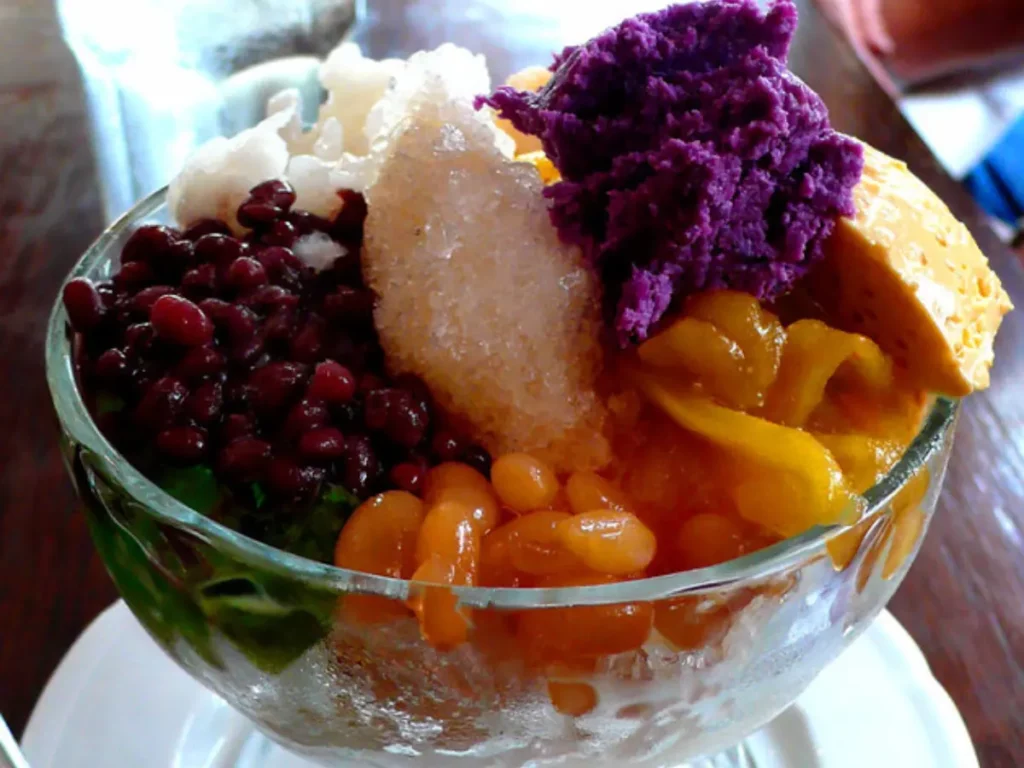
Even though, pituque is native to the Peruvian Highlands, it is also a part of Italian and French cuisine. “Gnocchi” is quite a famous dish to include purple potatoes in Italian cuisine.
To prepare this, they simply boil and mash it, then mix it with flour, egg and salt to form a dough. Then roll the dough into a rope and cut it into small pieces. Shape each piece by rolling it over a fork or gnocchi board. Then boil it in salted water until it floats.
Similarly, it was also introduced from South America to France and became an Incan King’s favorite. Therefore, they consider it a delicacy, which then became part of French cuisine. The type they use in their cuisine is “Vitelotte”. They usually serve it as “Gnocchi with Sage Butter” or “French Vitelotte Salad with Mustard Vinaigiratte.”
Currently, they are grown in the Casentino region of Tuscany. They call it “vitelotte noire.” Hence, it has been widely used due to its nutty flavor, vibrant colors, unique texture, and rich nutrient profile.
Moreover, you can also find some amazing recipes in the cookbook of a famous novelist Alexander Duma’s “Le Grand Dictionnaire de Cuisine,” published posthumously in 1873. Amazingly enough, he was also an expert chef.
Due to its sweet and nutty flavor and prominent colors, he personally liked the vegetable and added it into his own recipes.
Final Word
However, this exotic Andean spud reminds us that there is always more to explore and celebrate in the wondrous world of Peruvian cuisine. Which not only includes exotic tastes but also provides nutritional value to our menu. Hence, increases the chances of Including more nutrition to our diet.
Citations:
[1] https://www.sugarlovespices.com/homemade-purple-potato-gnocchi/
[2] https://theyummyvegan.com/blog/purplesweetpotatognocchi
[3] https://www.12fixes.com/articles/purple-potatoes-royal-super-spud
[4] https://itsavegworldafterall.com/mashed-purple-potatoes/
[5] https://keepingitrelle.com/sweet-potato-gnocchi/
[6] https://wanderingchickpea.com/2021/02/09/purple-sweet-potato-gnocchi-with-cilantro-mint-chutney/
[7] https://draxe.com/nutrition/purple-potatoes/
[8] https://www.specialtyproduce.com/produce/Purple_Potatoes_641.php
[9] https://www.healthline.com/nutrition/purple-potatoes
[10] https://www.mindbodygreen.com/articles/purple-potatoes
[11] https://parade.com/health/can-purple-potatoes-help-you-live-to-100-according-to-dietitians
[12] https://www.ncbi.nlm.nih.gov/pmc/articles/PMC8388894/
[13] https://savingdinner.com/health-benefits-of-purple-potatoes/
[14] https://pharmeasy.in/blog/unlocking-the-health-benefits-of-purple-potatoes/
[15] https://www.ncbi.nlm.nih.gov/pmc/articles/PMC8122721/
[16] https://fr.wikipedia.org/wiki/Vitelotte_noire
[17] https://en.wikipedia.org/wiki/Vitelotte
[18] https://specialtyproduce.com/produce/Vitelotte_Potatoes_12886.php
[19] https://www.eatingwell.com/article/7561504/health-benefits-of-purple-potatoes/
Also Check out this yummy blog on: Benefits of Eating Dark Chocolate
